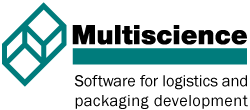MultiPack for Robots
In order to support the flexible use of palletizing and depalletizing robots with changing package formats, MultiPack for Robots efficiently generates and manages all of the necessary control information. MultiPack for Robots provides graphic information – step-by-step too – about the sequence of the overall palletizing process. This software system is individually adapted to the robots in use and their control system.
The performance of different system configurations as well as alternative designs for the gripper can already be analysed and evaluated in terms of the minimum number of robot cycles for the packing patterns specified by the customer in the planning phase for a robot palletizing system.
MultiPack for Robots is based on the proven structures and optimization algorithms in MultiPack. The optimization of the layer patterns takes into account all of the parameters defined by the robot hardware. The system operator can thus adjust the robot used to a different package format in only a few minutes, and does not require any knowledge of the robot’s control system.

Taking into account the characteristics of the robot and the gripper tool used, MultiPack for Robots determines the gripper cycle that takes the least time for each layer pattern. The interfering contours of the gripper and palletizing station (e.g. safety fences) are taken into account, as are the position of labels or the insertion of intermediate layers. The cycles created and sequence of cycles that have been optimized by MultiPack for Robots can of course be modified manually too.
MultiPack for Robots support vacuum, fork and clamping grippers. The grippers can optionally pick up and place several packages at once (MultiPick-MultiPlace). The individual placing of packages (MultiPick-SinglePlace) is also enabled for vacuum grippers with separated vacuum cycles as well as for divided clamp and fork grippers.
The software communicates with the gantry and articulated arm robot via different interfaces. These have various functions, from data output of the place coordinates through to the transmission of complete travel paths in online operation.
You can get more information on https://automated-palletizing.com.


